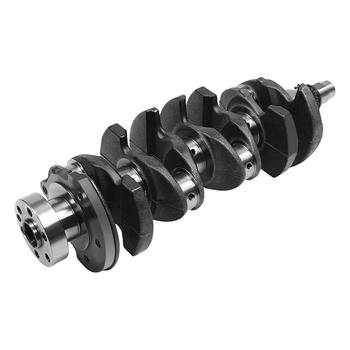Frankly speaking, the humble crankshaft might not be the first thing that comes to mind when you think about cutting-edge technology. However, recent innovations in crankshaft design and manufacturing have the potential to significantly improve engine performance. Let's take a closer look at some of the most exciting new developments in this field.
New Materials for Enhanced Durability
One of the most significant advancements in crankshaft technology is the use of new materials. Traditional crankshafts were made from cast iron or steel, but these materials have their limitations. For example, they can be heavy, which can reduce fuel efficiency and increase emissions. They can also be prone to wear and tear, which can lead to costly repairs or replacements.
Subsection 1: Composite Materials
To address these issues, some manufacturers are now turning to composite materials. These materials are made from a combination of fibers and resins, which can be tailored to specific performance requirements. For example, carbon fiber composites are extremely strong and lightweight, making them ideal for high-performance engines. They are also resistant to fatigue and corrosion, which can greatly extend the lifespan of the crankshaft.
Subsection 2: Powder Metallurgy
Another promising material for crankshafts is powder metallurgy. This process involves blending fine powders of metals and ceramics, which are then compacted and sintered to form a solid material. The resulting crankshafts are extremely dense and strong, with excellent wear resistance. They can also be precision-engineered to tight tolerances, which can improve engine efficiency and reduce emissions.
Innovative Designs for Improved Performance
In addition to new materials, innovative designs are also playing a key role in improving crankshaft performance. By optimizing the shape and geometry of the crankshaft, engineers can reduce friction and vibration, improve fuel efficiency, and increase power output.
Subsection 1: Asymmetrical Crankshafts
One example of an innovative crankshaft design is the asymmetrical crankshaft. Traditional crankshafts have a symmetrical design, with the crank pins spaced evenly around the centerline. However, this design can create imbalances and vibrations, which can reduce engine performance and increase wear and tear.
Asymmetrical crankshafts, on the other hand, have crank pins that are spaced unevenly. This design can help to balance the forces in the engine and reduce vibrations, resulting in smoother operation and improved efficiency. It can also increase power output by allowing for larger cylinders and higher compression ratios.
Subsection 2: Split Crankshafts
Another innovative design is the split crankshaft. This design involves splitting the crankshaft into two separate pieces, which are then joined together using a central bolt or other fastening mechanism. This design can significantly reduce the weight of the crankshaft, which can improve fuel efficiency and reduce emissions.
Split crankshafts can also be more easily customized for specific engine configurations. For example, the length of the crankshaft can be adjusted to optimize the stroke of the pistons, which can improve power output and efficiency. Additionally, split crankshafts can be more easily serviced and repaired, as individual components can be replaced without having to remove the entire crankshaft.
Advanced Manufacturing Processes
Finally, advances in manufacturing processes are also contributing to improvements in crankshaft technology. New techniques such as 3D printing and precision forging are allowing for more precise and efficient production of crankshafts, while also reducing waste and costs.
Subsection 1: 3D Printing
3D printing, also known as additive manufacturing, is a process that involves building up a three-dimensional object layer by layer. This technology has many potential applications in crankshaft manufacturing, including the ability to produce complex geometries and custom components quickly and cost-effectively.
3D printing can also be used to produce prototype crankshafts for testing and development. This can greatly reduce the time and cost associated with traditional prototyping methods, allowing manufacturers to bring new products to market more quickly and efficiently.
Subsection 2: Precision Forging
Precision forging is a manufacturing process that involves shaping metal using a series of dies and hammers. This process can produce crankshafts with extremely tight tolerances and excellent surface finishes, resulting in improved performance and durability.
Precision forging can also reduce waste and costs by minimizing the amount of material that needs to be removed during finishing operations. Additionally, it can produce crankshafts with consistent quality and uniformity, reducing the likelihood of defects and failures.
Conclusion
In conclusion, recent innovations in crankshaft technology are driving significant improvements in engine performance. By using new materials, innovative designs, and advanced manufacturing processes, engineers are able to produce crankshafts that are lighter, stronger, and more efficient than ever before. As a result, today's engines are able to deliver more power, better fuel efficiency, and reduced emissions, making them an increasingly attractive option for consumers and industry alike.




